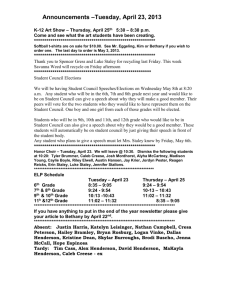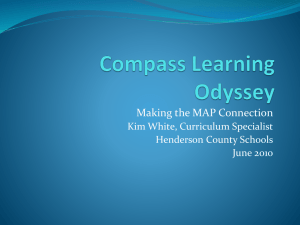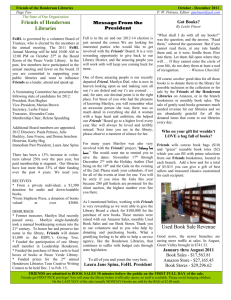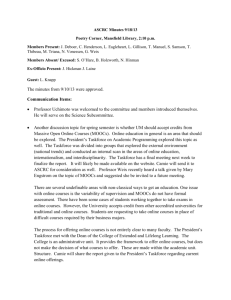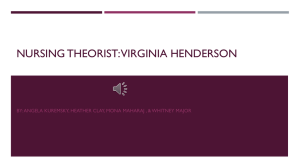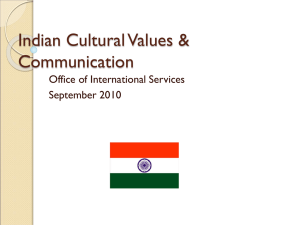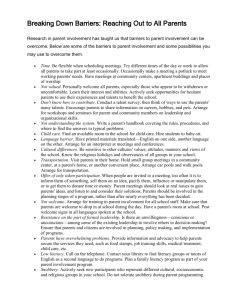Ledger of William Henderson
advertisement
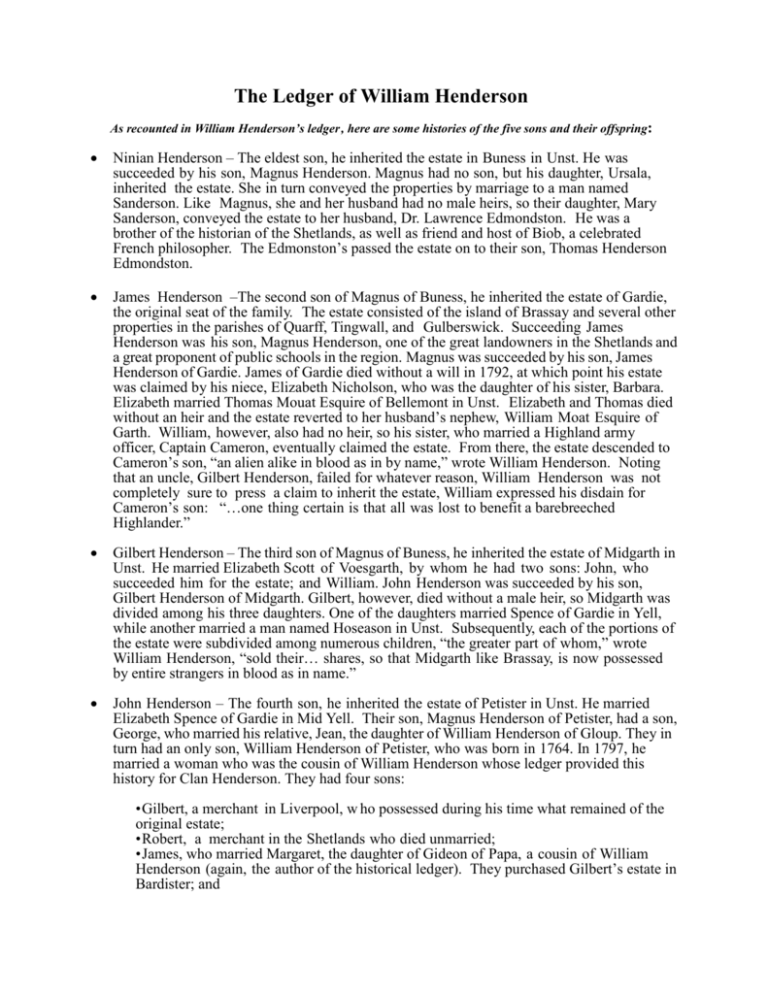
The Ledger of William Henderson As recounted in William Henderson’s ledger , here are some histories of the five sons and their offspring: Ninian Henderson – The eldest son, he inherited the estate in Buness in Unst. He was succeeded by his son, Magnus Henderson. Magnus had no son, but his daughter, Ursala, inherited the estate. She in turn conveyed the properties by marriage to a man named Sanderson. Like Magnus, she and her husband had no male heirs, so their daughter, Mary Sanderson, conveyed the estate to her husband, Dr. Lawrence Edmondston. He was a brother of the historian of the Shetlands, as well as friend and host of Biob, a celebrated French philosopher. The Edmonston’s passed the estate on to their son, Thomas Henderson Edmondston. James Henderson –The second son of Magnus of Buness, he inherited the estate of Gardie, the original seat of the family. The estate consisted of the island of Brassay and several other properties in the parishes of Quarff, Tingwall, and Gulberswick. Succeeding James Henderson was his son, Magnus Henderson, one of the great landowners in the Shetlands and a great proponent of public schools in the region. Magnus was succeeded by his son, James Henderson of Gardie. James of Gardie died without a will in 1792, at which point his estate was claimed by his niece, Elizabeth Nicholson, who was the daughter of his sister, Barbara. Elizabeth married Thomas Mouat Esquire of Bellemont in Unst. Elizabeth and Thomas died without an heir and the estate reverted to her husband’s nephew, William Moat Esquire of Garth. William, however, also had no heir, so his sister, who married a Highland army officer, Captain Cameron, eventually claimed the estate. From there, the estate descended to Cameron’s son, “an alien alike in blood as in by name,” wrote William Henderson. Noting that an uncle, Gilbert Henderson, failed for whatever reason, William Henderson was not completely sure to press a claim to inherit the estate, William expressed his disdain for Cameron’s son: “…one thing certain is that all was lost to benefit a barebreeched Highlander.” Gilbert Henderson – The third son of Magnus of Buness, he inherited the estate of Midgarth in Unst. He married Elizabeth Scott of Voesgarth, by whom he had two sons: John, who succeeded him for the estate; and William. John Henderson was succeeded by his son, Gilbert Henderson of Midgarth. Gilbert, however, died without a male heir, so Midgarth was divided among his three daughters. One of the daughters married Spence of Gardie in Yell, while another married a man named Hoseason in Unst. Subsequently, each of the portions of the estate were subdivided among numerous children, “the greater part of whom,” wrote William Henderson, “sold their… shares, so that Midgarth like Brassay, is now possessed by entire strangers in blood as in name.” John Henderson – The fourth son, he inherited the estate of Petister in Unst. He married Elizabeth Spence of Gardie in Mid Yell. Their son, Magnus Henderson of Petister, had a son, George, who married his relative, Jean, the daughter of William Henderson of Gloup. They in turn had an only son, William Henderson of Petister, who was born in 1764. In 1797, he married a woman who was the cousin of William Henderson whose ledger provided this history for Clan Henderson. They had four sons: • Gilbert, a merchant in Liverpool, w ho possessed during his time what remained of the original estate; • Robert, a merchant in the Shetlands who died unmarried; • James, who married Margaret, the daughter of Gideon of Papa, a cousin of William Henderson (again, the author of the historical ledger). They purchased Gilbert’s estate in Bardister; and • William, a captain in the merchant service who also lived in Liverpool. He purchased what remained of the estate of Gloup for 800 pounds. He was a widower and had only one child, a daughter, who married. David Henderson – The fifth child, he inherited his father ’s estate in Gloup in North Yell. He was succeeded by his son, who was named after King William, and the first, commented William Henderson in his report, to commit the “sacrilege” of not naming the eldest son after his grandfather. William Henderson of Gloup had a son, John, who was the father of Captain William Henderson of Gloup. Captain Henderson was a classmate of William Henderson’s for several months in 1792 at Ollaberry in the Shetlands. After leaving the school at Ollaberry, Captain Henderson studied law and became a pubic notary and kings messenger at Lerwick. Eventually, tired of the law, he obtained a commission in the 27th Regiment (infantry) in 1803. Stationed in Sicily, Italy, he rose to the rank of senior lieutenant. So attached was he to the corps that he refused the offer to command a second battalion when it was added to the 27th Regiment. At the battle of Waterloo on June 18, 1815, he saw his battalion nearly exterminated. Wounded in the foot himself, he was the only surviving senior officer in the field to bring his few surviving companions out of the battle. He retired to the Shetlands and died there some fifteen or so years later. Captain Henderson left two sons: John Henderson, a merchant in Liverpool; and Archibald Henderson, who resided with his mother at Gloup until her death. As mentioned previously, what remained of the Gloup estate was then sold to Captain Henderson of Petister. In 1803, William Henderson noted in his ledger that he was introduced to a Major Henderson of the British army, then stationed in a staff appointment in Chester, who was descended from the Hendersons of the Shetlands, although William noted that he did not recall from which of the five branches. Major Henderson told William that he believed that the celebrated Colonel Henderson, who gave his name to a city and a county in Kentucky, was related to the two of them. William Henderson’s journal also provided Clan Henderson with valuable information on the junior branch of the Hendersons in the Shetlands: William Henderson of Ollaberry—The grandfather of our ledger writer was born in 1705, the second son of Gilbert of Midgarth and grandson of Magnus of Buness. Leaving Unst, he moved to Northmavin, where he married Christian Murray, circa 1730. She was granddaughter of John, first Duke of Athole, and the widow of Andrew Gifford. William Henderson described her as a “lady of enlarged understanding and cultivated mind, happily united in her second wedlock to a husband whose talents and virtues rendered him universally respected and beloved; and by none more so than by his wife’s first family, to whom he was truly a father; and whose untimely deaths he deeply deplored.” William Henderson of Ollaberry died on 20 August 1764, at the age of 59. Christian died on 25 March 1783, at the age of 88. Both are buried in the churchyard of Ollaberry, where their eldest son erected a tombstone to their memory. Besides five sons by her first marriage all of whom died before her, Christian also had five sons by William Henderson of Ollaberry, but no daughters by either marriage. These last five were: Gilbert Henderson of Bardister – He was born in 1732 and died in 1803, after the death of his father and his five half- brothers. Gilbert believed that the estate of Ollaberry would be his on the death of his mother so he went to live there, remaining in possession of it for about 20 years. When his mother died, however, a descendent of one of his half-brothers suddenly appeared and turned him out. Gilbert then retired to Bardister, where he eventually acquired a small estate, married and raised a large family, and respectably settled his sons in business in Liverpool. His wife was Ann Gifford, the daughter of Gilbert Gifford and the sister of Dr. John Gifford of Urafirth. Consequently, she was the niece to Thomas Gifford of Busta, the historian. William Henderson wrote that Ann survived her husband by a few years and that she was “an amiable, loving creature.” On the other hand, he described his uncle Gilbert as indulging in “displays of an irritable temper.” He claimed that his uncle would blame this “defect” of character on Ann, “who, altho’ possessed of an amiable disposition herself, nevertheless became the medium by which the firey [sic] blood of the turbulent Murrays of Athole had inflamed the passions of the heretofore inoffensive descendants of Count Hemison.” The marriage of Gilbert and Ann produced three sons and five daughters: • The oldest boy was William, a partner for some years in the firm of Henderson, Sellar & Henderson, foreign merchants in Liverpool. After quarreling sharply with his brother, Gilbert, the head of the firm, William left to travel on the continent from 1814-15. He died at the age of 70 in 1823. Although unmarried, he produced two sons, William and Horatun, who both died before their father. • Gilbert, the second son, was born in 1750. He became a great merchant in Liverpool at an early age. In 1796, he married Jean, the oldest daughter of James Chyne (or Cheyne) Esquire of Tunwick in the Shetlands. She died many years before Gilbert, leaving him four sons and several daughters. He died in 1833 at the age of 83. The oldest, also named Gilbert, was educated at Oxford, studied law and married. He became a recorder of Liverpool and resided in London, where he died in December 1861. Before his death, he was included in the commission of the Peace for the Shetlands as Henderson of Bardister. He left no children. • Arthur, Gilbert and Ann’s second son, carried on the mercantile trade in Liverpool with his second brother, Robert. He died unmarried. • Robert Sellar Henderson, the third son, was named after his father ’s old partner, Robert Sellar. In addition to his inheriting his share of his father ’s property, Robert received a bequest of 80,000 pounds from old Sellar, his godfather. Unmarried, he died in 1848. • James, the youngest son, also died young and unmarried. One of his daughters, Ann, married a man named Phillips, who was in the Royal Navy. She died in 1858, leaving several children: a captain in the 47th Regiment; and Isabella, who married an officer in the Royal Navy and left two daughters. Since all the male descendents of Gilbert Henderson of Liverpool (the chief of the Henderson family) died, the family seniority reverted to the descendents of John Henderson, the youngest son of Gilbert of Bardister, who was born in 1760 and who became a Liverpool foreign merchant. In 1791, John married Mary, the daughter of Andrew Bolt, Esquire, of Lerwick and Cruister, the family estate of the Bolts. She was also the granddaughter of Sir John Mitchel of Westshore, near Scalloway. Since Mitchel died without a male heir, his estate eventually was completely sold or dispersed by 1792. John and Mary Henderson had four children. Mary, one of their four children, married a man named Lamb, a merchant in Glasgow. She died young, leaving several children. Two of her sons were officers in the army and were killed in India. John, the second child, studied at Oxford and practiced law in London. He was commissioned in the Peace for the Shetlands as John Henderson of Berry, a small estate near Scalloway which descended to him, through an aunt, from Sir John Mitchel. He also became head of the Hendersons in the Shetlands. The five daughters of Gilbert Henderson of Bardister were: • Christian, the eldest, who died at an old age, unmarried. • Ann, the second daughter, who lived several years with her brother, Gilbert, but returned to Bardister and lived there, also to an old age and unmarried. • Catharine, the third daughter, died in 1830, unmarried as well. • Anderina married in 1797 to William Henderson of Petister, by whom she had a large family. • Charlotte, the youngest, who was born in 1778. She married Magnus Hoseason, a schoolmaster in 1809, much to the dismay of her family, according to William Henderson’s ledger. They lived on a small property in Tingwall, bequeathed by her father. William Henderson records her death as occurring either in 1858 or 1859. William Henderson of Papa-The second son of William Henderson of Ollaberry, he went to live with the Laird of Busta (his widow, actually) in the mid-1700s. The Laird was the nephew of his mother ’s first husband. There, he became acquainted with Barbara Sinclair, daughter of Sinclair of Brew and niece to the Lady of Busta. After nine years of courtship, he married her. The Laird of Busta gave William a favorable lease of land on the island of Papa as a wedding present. William, Barbara and their children resided there until deaths broke up the families in 1855. After many years of suffering from gravel, an affliction of the kidneys and the urinary bladder, and which affected several of the Hendersons of the Shetlands, he died on June 15, 1799. Barbara survived him for more than 20 years. Her sister, Craigie Sinclair, died on March 22, 1834, at the age of 93. The Hendersons of Papa left three sons and three daughters: • William, the eldest, went to Liverpool in the mercantile trade. More inclined to literature than business, he was unsuccessful and died in Liverpool at an early age in 1795. • Barbara, the oldest daughter, died unmarried at the age of 90, possibly out of grief over the death the same week as her brother, Gideon, in 1855. • Alexander, the second son, was a merchant in Lerwick. He died unmarried at an early age, drowned on his way to Leith in 1813, along with John Scott of Melke. • Christian, the second daughter, married a merchant named Mouat in Lerwick in 1808. She died leaving several children, including an oldest son, who was a respectable merchant in Lerwick, and Alexander Mouat, her second son, who was a businessman in northern Canada. • Gideon, the third son, was born on Dec. 8,1775. He continued to reside in Papa as the head and support of the family after his father ’s death. He married Margaret E. Gray in 1812. She d ied in 1835 and Gideon died on March 12,1855, at the age of 80. He left several children: William, the oldest son, chose the mercantile navy as his profession. He rose to chief mate of the South Sea Trader. Unfortunately, cannibals on the Isle of Pines murdered him and the entire crew of the ship in 1841. William was 27 when he died. Walter, the second son, was born in Papa on April 25, 1816. He became a merchant in Quebec, married, and had a son and three daughters. He also served as a lieutenant in a company of volunteers during the rebellion of 1837-38. He died on May 13, 1865. Gideon, the third son, was a captain in the merchant service. He married and settled in Liverpool, and had several children. Margaret, the oldest daughter, was married to James (Cheyne) Henderson, the proprietor of Bardister. Elizabeth, the second daughter, was married to James Edie, a countryman of her own. They settled near Toronto and had several children. Sinclair, their youngest, was married to a man named Budge, from Yell. According to William Henderson’s ledger, he died in 1868. • Elizabeth, the youngest child of William Henderson of Papa, was born on Nov. 20, 1778. The journal describes her as “a smart, clever woman, managing much of the family business at Papa with her brother, Gideon, when the latter and her sister Barbara both died in the same week in 1855.” Alone, she then retired, first to Lerwick then to Bardister, where she lived with a married niece, Margaret (mentioned previously). In his ledger, William Henderson noted that Elizabeth eventually becameblind and paralyzed, but “much of what I know of the family of Henderson is derived from her pleasant and well written letters.” • Francis – The third son of William Henderson of Ollaberry, he died unmarried, killed at the siege of Havana in 1762. – William Henderson in his journal does not record the name of this child, but mentions that he “died in infancy at nurse.” Alexander – The fourth child of William Henderson of Ollaberry, he was born in Ollaberry in 1737. This child is the father of our ledger author, William Henderson. With a taste for mechanics, he was set to go to Edinburgh to learn shipbuilding when he turned nineteen. He was detained at home, however, by his father ’s increasing illness, termed “dumb Palsy” at the time. When his father died in 1764, Alexander felt he couldn’t leave his widowed mother alone. As a result, William Henderson recounts in his ledger, Alexander “wasted the best 14 years of his life and sacrificed every prospect for future competence.” Alexander ’s older brother was already married and head of the house of a large family. Alexander did leave his mother, however, in 1776, when he became a clerk factor to a man named Alexander Fraser, for whom he worked for four years. In 1780, Alexander obtained a lease on the island of Foula, which contained about eighty families. He settled there and married Mary Umphrey, who, wrote William Henderson, was born in 1754 to an “old, respectable but decayed family.” A terrible storm and flood in 1784 destroyed virtually everything they possessed. As William Henderson wrote, his father saved nothing “but myself, an infant in a cradle snatched out of the devastating flood at the hazard of his life, after having been washed out of the house, cradle and all.” Unable to pay the rent, he was forced by the proprietor to quit Foula and surrender the lease. Driven out of Foula, Alexander sheltered his family in a roofless storehouse on the island of Muckle Roe. Using his mechanical talent, he built a small sloop out of wrecked timber. The next year, he went to reside in Papa near his brother, William, and was employed at Sumburgh during the winter of 1786-87. In May of 1788, he went to Fetlar to manage the fishing business of Gifford and Edmondston. That winter, he built a two-story stone house with slate roof at Housetter. This would become his permanent, and last, residence. In the spring of 1789, the family moved from Papa to Housetter. Unfortunately, Alexander and his family were to face tragedies again. He was crushed by the loss of his wife Mary, who died of smallpox on 25 June 1791. Ironically, she had caught the disease from attending the children, who had been inoculated. She was buried at Ollaberry. Alexander and his wife had five children. The first died in infancy. The second was William Henderson, our journal author. The third was Gilbert, born on Papa on April 5, 1786. Mary, born in 1789, died in infancy. John, born in 1791, died a few weeks before his mother. William Henderson said his mother taught him to read and write a bit before he went to Urafirth in 1789, where he learned some Latin and writing. By April of 1799, William Henderson left for a new life in Quebec. By that time, however, his father went to Liverpool by invitation from his nephew, John. According to his journal, that previous year was not a pleasant one for either Alexander Henderson or Gilbert, the third child. At the time, a man named Devaynes, a Liverpool magistrate, persuaded Alexander Henderson to make Gilbert an apprentice to the man. For seven years, Gilbert made barrels (coopering, as it was called) at the docks or powder kegs for the slave trade. “His education neglected and youth wasted in the vilest slavery,” wrote William Henderson, “he had then to begin anew in another line of life.” After residing with his nephew at Liverpool for the year, Alexander returned to his old home in May of 1880. His niece, Christian, then came to live with him at Housetter for the few remaining years of his life. He became deathly ill, first with a cold, followed by diarrhea, all from having walked to Hillswick to deliver the last letter he would write to his son, William. Alexander Henderson died in the summer of 1806 at the age of 69. In the conclusion to his journal, William Henderson expressed the hope that “should events ever induce [my children] to visit Zetland, altho’ the race there is nearly extinct, they will find the name they bear not unkown; few will be the doors that do not open to welcome the descendents of Alexander Henderson who during his lifetime was a welcome guest at every gentlemen’s house from Sumburgh Head to the Scaw of Unst, not more regretted for his increasing misfortunes, than he was beloved for his many virtues, and respected for his ancestors.”
